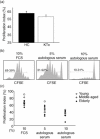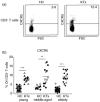How immunosuppressive therapy affects T cells from kidney transplanted patients of different age: the role of latent cytomegalovirus infection
- PMID: 24028181
- PMCID: PMC3958160
- DOI: 10.1111/cei.12205
How immunosuppressive therapy affects T cells from kidney transplanted patients of different age: the role of latent cytomegalovirus infection
Abstract
The average age of patients receiving renal transplantation is increasing as programmes have been established which support the donation of organs from elderly donors to older recipients. Little is known about the effect of immunosuppressive therapy on the immune system of older patients. In this study, T cell function and the composition of the T cell repertoire were analysed in immunosuppressed renal transplant recipients of different age and cytomegalovirus (CMV) status in comparison to age- and CMV-matched controls. Independent of age and CMV status, the production of interleukin (IL)-2 and interferon (IFN)-γ by T cells was decreased in the patient groups and autologous serum from patients was capable of inhibiting the proliferation of CD3⁺ T cells. CXCR5 expression on T cells was increased in patients versus controls reflecting reduced endogenous IL-2 signalling under immunosuppressive therapy. In CMV-seronegative patients kidney transplantation and immunosuppressive therapy did not induce changes in the CD8⁺ T cell pool, but there was a moderate increase in CD4⁺CD28⁻ effector T cells when compared to age-matched controls. In contrast, latent CMV infection triggered a shift from early to late differentiated CD4⁺ and CD8⁺ T cells in patients and controls. This shift was most pronounced in elderly transplant patients under immunosuppressive therapy. In conclusion, our results demonstrate that immunosuppressive therapy following kidney transplantation is effective in patients older than 65 years. Latent CMV infection, however, accelerates age-related changes in the T cell repertoire in elderly people under immunosuppressive therapy. These patients should therefore be monitored with special care.
Keywords: T cells; ageing; immunosuppressive therapy.
© 2013 British Society for Immunology.
Figures



Similar articles
-
[Monitoring of cytomegalovirus-specific CD4+ and CD8+ T cell responses by cytokine flow cytometry in renal transplant recipients].Mikrobiyol Bul. 2016 Apr;50(2):224-35. Mikrobiyol Bul. 2016. PMID: 27175495 Turkish.
-
Analyzing T-cell responses to cytomegalovirus by cytokine flow cytometry.Hum Immunol. 2004 May;65(5):493-9. doi: 10.1016/j.humimm.2004.02.004. Hum Immunol. 2004. PMID: 15172449 Review.
-
Rapid T cell repopulation after rabbit anti-thymocyte globulin (rATG) treatment is driven mainly by cytomegalovirus.Clin Exp Immunol. 2012 Sep;169(3):292-301. doi: 10.1111/j.1365-2249.2012.04622.x. Clin Exp Immunol. 2012. PMID: 22861369 Free PMC article.
-
CMV drives the expansion of highly functional memory T cells expressing NK-cell receptors in renal transplant recipients.Eur J Immunol. 2017 Aug;47(8):1324-1334. doi: 10.1002/eji.201747018. Epub 2017 Jul 3. Eur J Immunol. 2017. PMID: 28586095
-
CMV Infection and CMV-Specific Immune Reconstitution Following Haploidentical Stem Cell Transplantation: An Update.Front Immunol. 2021 Oct 28;12:732826. doi: 10.3389/fimmu.2021.732826. eCollection 2021. Front Immunol. 2021. PMID: 34777342 Free PMC article. Review.
Cited by
-
Decreased frequency of Th22 cells and IL-22 cytokine in kidney transplant patients with active cytomegalovirus infection.BMC Immunol. 2023 Jul 4;24(1):18. doi: 10.1186/s12865-023-00555-2. BMC Immunol. 2023. PMID: 37403036 Free PMC article.
-
Evolution of Cytomegalovirus-Responsive T Cell Clonality following Solid Organ Transplantation.J Immunol. 2021 Oct 15;207(8):2077-2085. doi: 10.4049/jimmunol.2100404. Epub 2021 Sep 22. J Immunol. 2021. PMID: 34551964 Free PMC article.
-
Human Regulatory T Cells: Understanding the Role of Tregs in Select Autoimmune Skin Diseases and Post-Transplant Nonmelanoma Skin Cancers.Int J Mol Sci. 2023 Jan 12;24(2):1527. doi: 10.3390/ijms24021527. Int J Mol Sci. 2023. PMID: 36675037 Free PMC article. Review.
-
Functional Consequences of Memory Inflation after Solid Organ Transplantation.J Immunol. 2021 Oct 15;207(8):2086-2095. doi: 10.4049/jimmunol.2100405. Epub 2021 Sep 22. J Immunol. 2021. PMID: 34551963 Free PMC article.
-
Risk factors for cytomegalovirus disease in seropositive renal transplant recipients; a single-center case-controlled study.J Nephropathol. 2017 Jul;6(3):240-247. doi: 10.15171/jnp.2017.39. Epub 2017 Apr 2. J Nephropathol. 2017. PMID: 28975107 Free PMC article.
References
-
- Cohen DJ, St Martin L, Christensen LL, Bloom RD, Sung RS. Kidney and pancreas transplantation in the United States, 1995–2004. Am J Transplant. 2006;6:1153–1169. - PubMed
-
- Danovitch GM, Cohen DJ, Weir MR, et al. Current status of kidney and pancreas transplantation in the United States, 1994–2003. Am J Transplant. 2005;5:904–915. - PubMed
-
- Meier-Kriesche HU, Port FK, Ojo AO, et al. Effect of waiting time on renal transplant outcome. Kidney Int. 2000;58:1311–1317. - PubMed
-
- Oniscu GC, Brown H, Forsythe JL. Impact of cadaveric renal transplantation on survival in patients listed for transplantation. J Am Soc Nephrol. 2005;16:1859–1865. - PubMed
-
- Wolfe RA, Ashby VB, Milford EL, et al. Comparison of mortality in all patients on dialysis, patients on dialysis awaiting transplantation, and recipients of a first cadaveric transplant. N Engl J Med. 1999;341:1725–1730. - PubMed
Publication types
MeSH terms
Substances
LinkOut - more resources
Full Text Sources
Other Literature Sources
Medical
Research Materials

